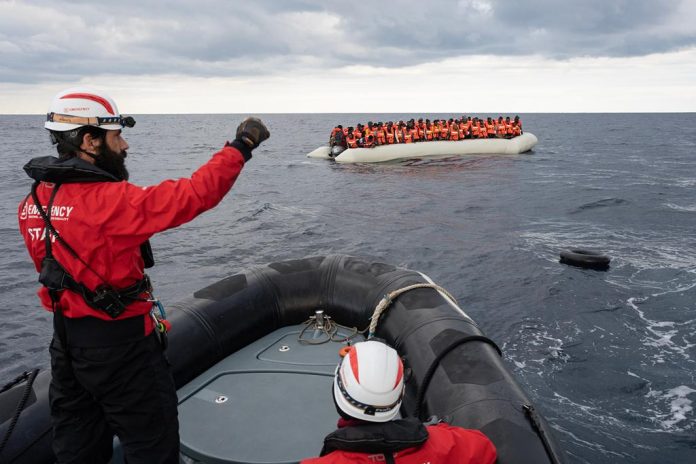TWO WOMEN ARE AMONG THE RESCUED AND 28 UNACCOMPANIED MINORS. MANY REPORT VIOLENCE IN LIBYA
EMANUELE NANNINI, PROJECT COORDINATOR FOR LIFE SUPPORT: “BOTH BOATS RESCUED HAD OBVIOUS NAVIGATIONAL PROBLEMS. THE LIVES OF THESE PEOPLE WERE AT RISK IF WE HAD NOT FOUND THEM IN TIME.”
In the port of Civitavecchia at 08:30 a.m., EMERGENCY began disembarking the 156 people rescued in the early morning hours of 16 February by the ship Life Support in two different rescue operations.
The 156 rescued people are from Bangladesh, Pakistan, Sudan, Eritrea, Egypt, Gambia, Chad, Cameroon, Senegal, Mali, Nigeria, Ivory Coast and Guinea. Among them are two women (including one mother of three children between the ages of 7 and 10) and 28 unaccompanied minors.
Many of the rescued people speak of being arbitrarily detained in Libya, where they suffered violence.
“Today is the first day of my life,” comments Iusef, one of the rescued men, whose body bears the marks of the violence he suffered in Libya. “I did not want to spend my life being a soldier and waging war, so I left my country after finishing high school. My younger brother decided to leave with me but unfortunately in Libya we were split up and now I have no idea where he is. It is hard to feel safe now knowing that he at this exact moment is probably still in some Libyan jail. I am 26 years old but I have decided not to count the three years I spent in Libya, as if my life stopped there and only resumed today.”
“For two years I travelled alone, knowing that there was no one there to help me and that I was the only one who would take care of me. Many times I thought about my parents, who remained in Nigeria,” says Keda, one of the 28 unaccompanied minors aboard Life Support. “Now I feel a huge responsibility. My family has made huge sacrifices to get me here and I will now do the same for them.”
Life Support conducted two consecutive rescue operations. The first involved a small wooden boat in distress in international waters, which was spotted shortly after midnight in the early morning hours of 16 February. After alerting the relevant authorities, the EMERGENCY team began rescue operations. The 46 rescued men came from Bangladesh, Pakistan, Sudan, Eritrea and Egypt. After completing the rescue operations and informing the authorities, Life Support asked for a place of safety (POS) where the rescued people could be disembarked. While waiting for a response, it resumed search activities for a boat in poor condition that had been reported by those rescued.
Around 08:30 a.m., an hour after receiving the POS of Civitavecchia, Life Support spotted another vessel in distress, a grey inflatable boat about ten metres long. Life Support began rescue operations in coordination with the Italian MRCC. There were 110 people onboard. Operations ended at 11:30 a.m.
So far there are no traces of the boat reported by the people from the first rescue.
“During the two rescue operations, we were the only NGO in international waters in the SAR zone. Both boats rescued had obvious navigational problems. The lives of these people were at risk if we had not found them in time,” says Emanuele Nannini, Project Coordinator for Life Support. “For us, the purpose of this mission is to save the lives of people who are fleeing war, torture and situations of suffering. Civil society is trying to fill a void that has been created by the indifference and short-sightedness of government institutions that, on the one hand, are not guaranteeing safe channels to come to Europe and, on the other, are doing everything to make sure that the deadliest frontier of migration is left unprotected. Our mandate is to continue saving lives at sea.”

